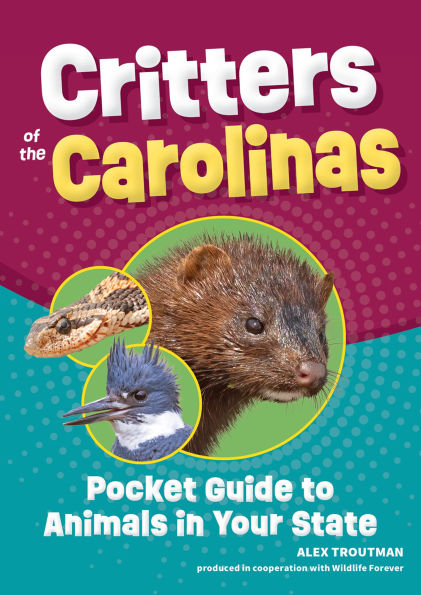Get the perfect kids’ introduction to mammals, birds, reptiles, and amphibians in North Carolina and South Carolina.
Put nature in the hands of children! Critters of the Carolinas is your wildlife pocket guide that’s informative, concise, and easy to use. Written by wildlife biologist Alex Troutman, this handy book presents 64 critters of North Carolina and South Carolina—if an animal is in this book, it’s found in the Carolinas.
Each species is showcased in a professional-quality photograph that’s paired with such neat-to-know details as habitat, range, and preferred food sources. Illustrations of the critter’s tracks complement the information, and a “Did You Know?” paragraph provides fascinating trivia worth sharing with family, friends, and teachers. Critters of the Carolinas includes important-to-know mammals, birds, reptiles, and amphibians.
Book Features:
- 64 critters—only animals of the Carolinas
- Full-color photos of every species
- Concise descriptions and interesting “Did You Know?” facts
- Attractive layout with kid appeal
- A portion of the proceeds from the sale of this book benefits Wildlife Forever to support their conservation efforts
Get the perfect kids’ introduction to mammals, birds, reptiles, and amphibians in North Carolina and South Carolina.
Put nature in the hands of children! Critters of the Carolinas is your wildlife pocket guide that’s informative, concise, and easy to use. Written by wildlife biologist Alex Troutman, this handy book presents 64 critters of North Carolina and South Carolina—if an animal is in this book, it’s found in the Carolinas.
Each species is showcased in a professional-quality photograph that’s paired with such neat-to-know details as habitat, range, and preferred food sources. Illustrations of the critter’s tracks complement the information, and a “Did You Know?” paragraph provides fascinating trivia worth sharing with family, friends, and teachers. Critters of the Carolinas includes important-to-know mammals, birds, reptiles, and amphibians.
Book Features:
- 64 critters—only animals of the Carolinas
- Full-color photos of every species
- Concise descriptions and interesting “Did You Know?” facts
- Attractive layout with kid appeal
- A portion of the proceeds from the sale of this book benefits Wildlife Forever to support their conservation efforts

Critters of the Carolinas: Pocket Guide to Animals in Your State

Critters of the Carolinas: Pocket Guide to Animals in Your State
Related collections and offers

Product Details
| ISBN-13: | 9781647555559 |
|---|---|
| Publisher: | Adventure Publications, Incorporated |
| Publication date: | 11/04/2025 |
| Series: | Wildlife Pocket Guides for Kids |
| Sold by: | Barnes & Noble |
| Format: | eBook |
| Age Range: | 7 - 12 Years |
